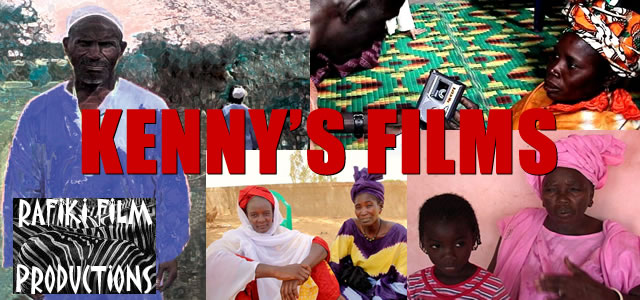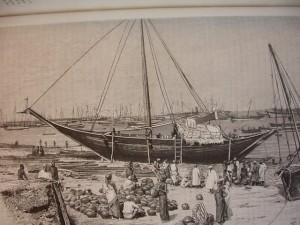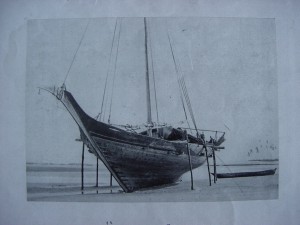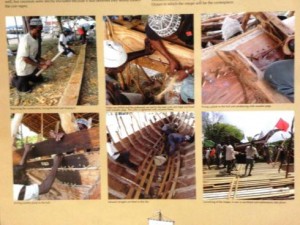Films
By kenny
THE MTEPE SHUNGWAYA SAILS AGAIN
A Tribute to the Boat-Builders of Lamu
Documentary Film. 13 minutes. Color.

This mtepe was beached for loading in Zanzibar in 1888. Dr. David Livingstone used mtepe to transport his camels.

The mtepe is distinguished by its long, arching prow, which is said to symbolize the head of a camel.
In 2003, Professor Abdul Sheriff of the Museum of Antiquities in Zanzibar, had raised money to build a half-sized model of an mtepe (m-teh-peh) – a trading ship that plied the East African coast for centuries but was last seen in 1935. A typical boat would have been about 100 feet long, 24 feet wide and over nine feet deep, and is estimated at 18 tons. A boat-builder named Muhammed Bwana was located on the island of Lamu in northern Kenya. He had learned the craft from his grandfather and was brought to Zanzibar with his family to build the model boat entirely from memory, without plans or drawings. The mtepe was named “Shungwaya” after a mythical kingdom along the coast between Kenya and Somalia. After eight months, the boat was completed and launched in December, 2003.
I was asked to pull together a short film about the building of the Shungwaya, using footage that had been shot by volunteers and was intended as archival material for the museum. I happened to be in Zanzibar for the screening of my film BEAUTIFUL TREE, SEVERED ROOTS (see below), where I was introduced to editor Shams Bhanji. Finding moments here and there during the madness of the Zanzibar International Film Festival (ZIFF), Shams and I worked on a shady rooftop to pull the footage into shape.
This short film will be screened at the San Diego Maritime Museum on October 2 as part of a fund-raising festival for the non-profit Kaskazi Environmental Alliance (KEA) of San Jose, CA. Headed by Kenyan Mahmoud Jillo, KEA aims to increase awareness, stewardship and conservation of East Africa’s coastal resources, particularly the mangrove swamps and reefs. An earlier film of Ms. Mann’s, titled THE SWAHILI BEAT – A Brief History of the East African Coast as told through the music and dance of the coastal people – will be screened at the Ocean Institute at Dana Point, CA, ( http://www.ocean-institute.org/index.html) as part of the fund-raising event. The full 4-day program of events may be viewed at http://www.keainc.org .
BEAUTIFUL TREE, SEVERED ROOTS
Documentary film. 70 minutes. Color/black-and-white.
My parents were Polish Romanian secular Jews and Socialists who fled Europe to settle in Kenya in 1942. Born and raised there, I examine how their Jewish Socialist values enabled them to fully adapt to and profoundly identify with Africa and Africans. While British settlers claimed land and exploited African people, my parents devoted their lives to fighting hunger, disease and poverty and were politically influential.
Set against the backdrop of their lives between the Mau Mau uprising of the 1950s and Independence in 1963, I examine my own identity as a “British” girl in an Eastern European family, as a white in an African country and as an anti-colonialist in a colony, presenting a fascinating examination of Jewish identity and an exposition of Kenya’s colonial history from a unique point of view.
BEAUTIFUL TREE, SEVERED ROOTS has evolved out of about 30 years of thinking, writing, gathering documents, interviews and information and struggling to tell this story in a way that is both personal and has universal resonance. It began as a book called RIDING THE EQUATOR, which was never published and which forms the backbone of my film. It is for this reason that I’ve structured BEAUTIFUL TREE in actual chapters, just like the book, and while I did that initially as an experiment, I am very happy with the freedom this format allows me.
Shot in Kenya, Poland and Romania, the unconventional format of six chapters utilizes live and archival footage, a variety of visual elements, my parents’ voices culled from 30 years of cassette tape correspondence, music, and my own narration.
Price:
- Individuals: US$ 35.00 in a jewel case
- Library, Non-Profit, University: US$ 250.00 in a jewel case
WALKING WITH LIFE
The Birth of a Human Rights Movement in Africa
WALKING WITH LIFE is the umbrella title for three films, available as a collection on one DVD.
WALKING WITH LIFE
Documentary film. 35 mns. Color.
Shot in Senegal, this film follows the work of Tostan (the word means “breakthrough” in the Wolof language)- a non-profit organization that brings human rights education to rural and urban people in Senegal, Guinea and many other African countries. Learn more about the film and about human rights education
TOSTAN: BUILDING PARTNERSHIPS THROUGH HUMAN RIGHTS EDUCATION
Documentary film. 34 mns. Color.
This is the companion film to WALKING WITH LIFE. Administrators and participants in the Tostan program describe how the program has evolved from its roots over 30 years ago. Their philosophy of promoting indigenous African culture in order to teach human rights has enabled them to build long-lasting partnerships with Islamic leaders, with African communities and with individual participants, seen as key in the movement toward positive and sustainable social change.
HUMAN RIGHTS CITIES: PATHS TO PEACE
Documentary film. 16 mns. Color.
A natural outcome of the movement to teach human rights around the world has been the development of Human Rights Cities in several countries – an initiative of Shulamith Koenig, Founder and Director of the People’s Decade for Human Rights Learning (www.pdhre.org) . This film documents the process in the town of Thies, Senegal, and in Washington, D.C. – the first American city to make this commitment.
Price for this DVD (3 films):
- Individuals: US$ 45.00, in a jewel case
- Library, Non-Profit, University: US$ 275.00 in a DVD box
THE SWAHILI BEAT
Documentary. 27:45mns. Color.
This film is an upbeat look at the remarkable history of the Swahili people of the East African coast. Packed with the music and dance of its indigenous peoples, the film takes viewers along the coast from the fabled island of Lamu to Zanzibar, Bagamoyo and Dar es Salaam, tracing the development of the Swahili culture through the intermarriage of Arab settlers arriving from Oman in the 8th century with local Africans.
The emergence of the Swahili as prosperous merchant brokers in the Indian Ocean basin and in the growing slave trade made them a lucrative target for successive waves of settlers, invaders and colonizers, including the Persians, Portuguese, Germans and British. The Swahili have withstood all these invasions and maintained their culture until today. Can they survive in the face of globalization, the Internet and tourism? This film is distributed by Documentary Educational Resources: www.der.org
Price:
- Individuals: US$ 25.00 in a jewel case
- Library, Non-Profit, University: US$65 in a jewel case
INDIA – AND OTHER THOUGHTS
Documentary. 56mns. Color.
In 2004, I traveled around southern India alone for two months. I never intended to make a film, but simply took still shots with a tiny old Canon digital camera, and recorded a travel journal on mini-casette tapes. Half way through the trip, I discovered that my camera could make 15-second movies. Aha! When I got home, I thought I would arrange a (boring) slide show for my friends. Four months later, I had put together this film-book-thing on Windows Movie Maker – a really primitive program not intended for complex sound mixing or nice dissolves! But I had fun – so here it is!
Price: US$ 25.00 in a jewel case
SURRENDER
Experimental short film. 16mm 14:03 mns. Black/white.
A woman has decided to move from one “state of being” to another. She spends the last day of her current “incarnation” on a beach, observing the people around her. Their activities become a poetic metaphor for the human condition and the transience of life.The film was shot on Sagg Main Beach in Sagaponack, Long Island, with Megan Chaskey as the lead. A trained Buddhist, she adds to the project a profound spiritual dimension.
Price: US$ 25.00 in a jewel case
POWER PLAY
16mm, 5:35mns. Black/white. 1973.
This short was made in Hamburg, Germany, in 1973. It features Dragan Todorovic, a Czechoslovakian puppeteer who tells a story of the oppressed and the oppressor simply through the magical movements of his hands. Music for this short film was specially composed by Volker Kunze.
Price: US$ 20.00 in a jewel case
SUNDIATA-THE LEGACY OF THE GRIOT
Animation. 6mns. Color
This film retells the legend of Sundiata, the famous thirteenth century King of Mali. Live African musicians and a traditional griot perform the piece as oral history to accompany the narrative and the magnificent, colorful paintings. The film is intended for supplementary use in schools, grades 5-8, but is also entertaining and informative for any audience.
Written by Kenny Mann; narrated by Afemo Omilami; produced by Jeanne Jacoby; directed by Joel Gilmore;griotand Kora musician – Morikeba Kouyate; drummer – Oginga Love; paintings by Vern Edwards. Harcourt/Brace/Jovanovitch.
NOT FOR SALE
EARTHWATCH SAMBURU RESEARCH INITIATIVE
Documentary. 13 mns. Color.
The Samburu Conservation Research Initiative (CRI) is a remarkable program for wildlife preservation in northern Kenya. With four well-established scientific projects based in northern Kenya’s arid Samburu country, Earthwatch realized that their efforts to conserve wildlife would be meaningless without the involvement of the local Samburu people. This short film illustrates some of the main problems effecting the Samburu and impacting local wildlife, and looks at ways in which Earthwatch trains Samburu people to actively participate in wildlife conservation, to the benefit of themselves, their lands, the wildlife and ultimately the Kenya economy. I made this film free of charge, as my donation to Earthwatch and to Kenya.
Camera: Kenny Mann; Camera and editing: Oscar Mann
NOT FOR SALE









